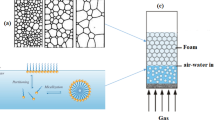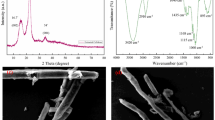Abstract
In order to ensure the thermal safety of nitrocellulose (NC) mixtures in the process of handing, storage, and usage, it is necessary to obtain the thermal stability and fire hazard of NC with different humectants. In this study, the thermogravimetry experiments with four heating rates (5, 10, 15, 20 C min−1) under nitrogen and air atmospheres were performed to investigate the thermal stability of two NC-humectants, namely NC-water and NC-ethanol mixtures, and pure NC. Moreover, the influence of humectants on the fire hazard of NC was evaluated by the ISO 5660 Cone Calorimeter test. The humectant, water or ethanol, can increase the activation energy and reduce the fire risk of NC. Compared with the NC with water, the NC with ethanol exhibits lower activation energy and higher fire hazard.















Similar content being viewed by others
Abbreviations
- A :
-
Pre-exponential factor
- c :
-
Specific heat/kJ kg−1°C−1
- C:
-
The orifice flow meter calibration constant
- a − b :
-
Constants known as the compensation effect parameters
- a 1 − b 1 :
-
Coefficients in describing critical heat flux
- E :
-
Activation energy/kJ mol−1
- E 0 :
-
Energy released per unit mass of O2 consumed/kJ kg−1
- f(\( \alpha \)):
-
The dependence of the reaction rate on the extent of conversion
- g(\( \alpha \)):
-
The integral form of the reaction model
- h c :
-
Convective heat transfer coefficient
- k :
-
Thermal conductivity/W m−1°C−1
- m v :
-
Evaporation content of humectant
- m r :
-
Mass loss range of decomposition of NC samples
- \( \dot{m}_{{{\text{O}}_{2} }} \) :
-
Mass flow rate of O2 after the ignition of the material/kg s−1
- \( \dot{m}_{{{\text{O}}_{2} }}^{0} \) :
-
Mass flow rates of O2 before the test/kg s−1
- \( \Delta \) p :
-
The orifice meter pressure differential
- \( \dot{Q} \) :
-
Heat release rate/kW
- \( \dot{Q}^{''} \) :
-
Heat release rate intensity measured from the cone calorimeter/kW m−2
- \( \dot{q}^{''} \) :
-
Incident radiant heat flux/kW m−2
- t :
-
Time
- T :
-
Temperature/°C
- T e :
-
Absolute temperature of the gas at the orifice meter
- T on :
-
Onset decomposition temperature
- T m :
-
Maximum decomposition temperature
- T 0 :
-
Initial temperature of the sample
- R:
-
Gas constant/J mol−1 K−1
- w :
-
Mass ratio measured in TG (= W/Wo)
- W :
-
Mass of the sample in TG/mg
- W o :
-
Initial sample mass in TG/mg
- x :
-
Flashover propensity
- \( \alpha \) :
-
Extent of conversion
- \( \beta \) :
-
Heating rate
- σ :
-
Stefan–Boltzmann constant/W m−2 K−4
- ε :
-
Emissivity
- ρ :
-
Density/g m−2
- av:
-
Average
- i:
-
Different heating rates
- ig:
-
Ignition
- on:
-
Onset
References
Hassan MA. Effect of malonyl malonanilide dimers on the thermal stability of nitrocellulose. J Hazard Mater. 2001;88(1):33–49.
Fu G, Wang J, Yan M. Anatomy of Tianjin port fire and explosion: process and causes. Process Saf Prog. 2016;35(3):216–20.
Tomaszewski W, Cieślak K, Zygmunt A. Influence of processing solvents on decomposition of nitrocellulose in smokeless powders studied by heat flow calorimetry. Poly Degrad Stab. 2015;111:169–75.
Relational Information System for Chemical Accident Database(RISCAD) http://riodb.ibase.aist.go.jp/riscad/index.php. Accident ID: 84.
Tziarras Z. Cyprus—after the tragedy of July 11th, 2011. Glob Polit. 2011.
Zhao B. Facts and lessons related to the explosion accident in Tianjin Port, China. Nat Hazards. 2016;54:1–7.
Katoh K, Soramoto T, Higashi E, Kawaguchi S, Kumagae K, Ito S, et al. Influence of water on the thermal stability of nitrocellulose. Sci Technol Energ Mater. 2014;75(1–2):44–9.
Dauerman L, Tajima Y. Thermal decomposition and combustion of nitrocellulose. Aiaa J. 1968;6(8):1468–73.
Jr JEH, Zack PJ. Thermal decomposition of nitrocellulose propellants. J Forensic Sci. 1977;22(2):332–6.
Liu H, Fu R. Studies on thermal decomposition of nitrocellulose by pyrolysis-gas chromatography. J Anal Appl Pyrolysis. 1988;14(2–3):163–9.
Nakamura H, Matsuura N, Akiyosi M, Hara Y. The exothermal decomposition of nitrocellulose in mixed acids. J Jpn Explos Soc. 2000;61:108.
Mahajan R, Makashir P, Agrawal J. Combustion behaviour of nitrocellulose and its complexes with copper oxide. hot stage microscopic studies. J Therm Anal Calorim. 2001;65(3):935–42.
Nakamura H, Nishi M, Akiyoshi M, Hara Y. Thermal degradation of nitrocellurose at low temperature. Kayaku Gakkaishi/J Jpn Explos Soc. 2002;63(3):121–7.
Phillips RW, Orlick CA, Steinberger R. The kinetics of the thermal decomposition of nitrocellulose. J Phys Chem. 2002;59(10):1034–9.
Pourmortazavi S, Hosseini S, Rahimi-Nasrabadi M, Hajimirsadeghi S, Momenian H. Effect of nitrate content on thermal decomposition of nitrocellulose. J Hazard Mater. 2009;162(2):1141–4.
Sovizi MR, Hajimirsadeghi SS, Naderizadeh B. Effect of particle size on thermal decomposition of nitrocellulose. J Hazard Mater. 2009;168(2–3):1134–9.
Katoh K, Ito S, Kawaguchi S, Higashi E, Nakano K, Ogata Y, et al. Effect of heating rate on the thermal behavior of nitrocellulose. J Therm Anal Calorim. 2010;100(1):303–8.
Wei W, Cui B, Jiang X, Lu L. The catalytic effect of NiO on thermal decomposition of nitrocellulose. J Therm Anal Calorim. 2010;102(3):863–6.
Katoh K, Le L, Arai M, Tamura M. Study on the spontaneous ignition of cellulose nitrate effect of the type of storage atmosphere (II). Sci Technol Energ Mater. 2003;64(6):236–40.
Katoh K, Ito S, Ogata Y, Kasamatsu JI, Miya H, Yamamoto M, et al. Effect of industrial water components on thermal stability of nitrocellulose. J Therm Anal Calorim. 2010;99(1):159–64.
Guo S, Wang Q, Sun J, Liao X, Wang ZS. Study on the influence of moisture content on thermal stability of propellant. J Hazard Mater. 2009;168(1):536–41.
Wei R, He Y, Liu J, He Y, Mi W, Yuen R, et al. Experimental study on the fire properties of nitrocellulose with different structures. Materials. 2017;10(3):316.
WJ9028-2005. Specification for Nitrocellulose of Lacquers. National Defense Science and Technology Industry Committee, 2005.
Jessup RS, Prosen E. Heats of combustion and formation of cellulose and nitrocellulose (cellulose nitrate). J Res Natl Bur Std. 1950;44:387.
He Y, He Y, Liu J, Li P, Chen M, Wei R, et al. Experimental study on the thermal decomposition and combustion characteristics of nitrocellulose with different alcohol humectants. J Hazard Mater. 2017;340:202.
ISO 5660-1: 2002. Reaction-to-fire tests—heat release, smoke production and mass loss rate—part 1: Heat release rate(cone calorimeter method).
Babrauskas V, Grayson SJ. Heat release in fires[M]. Elsevier Applied Science; 1992.
Chen M, Liu J, Lin X, Huang Q, Yuen R, Wang J. Combustion characteristics of primary lithium battery at two altitudes. J Therm Anal Calorim. 2016;124(2):865–70.
Liu J, Chen M, Lin X, Yuen R, Wang J. Impacts of ceiling height on the combustion behaviors of pool fires beneath a ceiling. J Therm Anal Calorim. 2016;126(2):881–9.
Zhou Z, Wang J, Liu J, Li H, Yuen R. Effect of the ambient pressure on the heat release rates of n-heptane pool fires. J Therm Anal Calorim. 2016;126(3):1727–34.
Chen M, Yuen R, Wang J. An experimental study about the effect of arrangement on the fire behaviors of lithium-ion batteries. J Therm Anal Calorim. 2017;129(1):181–8.
Akahira T, Sunose T. Method of determining activation deterioration constant of electrical insulating materials. Res Rep Chiba Inst Technol (Sci Technol). 1971;16:22–31.
Kissinger HE. Reaction kinetics in differential thermal analysis. Anal Chem. 1957;29(11):1702–6.
Friedman HL. Kinetics of thermal degradation of charforming plastics from thermogravimetry. Application to a phenolic plastic. Journal of Polymer Science: Polymer Symposia; 1964: Wiley.
Xu L, Jiang Y, Wang L. Thermal decomposition of rape straw: pyrolysis modeling and kinetic study via particle swarm optimization. Energy Convers Manag. 2017;146:124–33.
Sánchez-Jiménez PE, Pérez-Maqueda LA, Perejón A, Criado JM. Generalized master plots as a straightforward approach for determining the kinetic model: the case of cellulose pyrolysis. Thermochim Acta. 2013;552:54–9.
Sánchez-Jiménez PE, Pérez-Maqueda LA, Perejón A, Criado JM. A new model for the kinetic analysis of thermal degradation of polymers driven by random scission. Poly Degrad Stab. 2010;95(5):733–9.
Vyazovkin S, Burnham AK, Criado JM, Pérez-Maqueda LA, Popescu C, Sbirrazzuoli N. ICTAC kinetics committee recommendations for performing kinetic computations on thermal analysis data. Thermochim Acta. 2011;520(1–2):1–19.
Luche J, Rogaume T, Richard F, Guillaume E. Characterization of thermal properties and analysis of combustion behavior of PMMA in a cone calorimeter. Fire Saf J. 2011;46(7):451–61.
Zhang T, Zhou X, Yang L. Experimental study of fire hazards of thermal-insulation material in diesel locomotive: aluminum-polyurethane. Materials. 2016;9(3):168.
Yang HY, Zhou XD, Yang LZ, Zhang TL. Experimental Studies on the flammability and fire hazards of photovoltaic modules. Materials. 2015;8(7):4210–25.
Janssens ML. Measuring rate of heat release by oxygen consumption. Fire Technol. 1991;27(3):234–49.
Huggett C. Estimation of rate of heat release by means of oxygen consumption measurements. Fire Mater. 1980;4(2):61–5.
GB 50016-2006. Code of design on building fire protection and prevention, Ministry of Construction of China. Beijing: Standards Press; 2006.
GB 50074-2002. Code for design of oil depot, Ministry of Construction of China. Standards Press: Beijing; 2002.
Petrella RV. The assessment of full-scale fire hazards from cone calorimeter data. J Fire Sci. 1994;12(1):14–43.
Chow W, Han S. Studies on fire behaviour of video compact disc (VCD) materials with a cone calorimeter. Poly Test. 2004;23(6):685–94.
Chow WK. Fire hazard assessment on polyurethane sandwich panels for temporary accommodation units. Poly Test. 2004;23(8):973–7.
Saeed B, Leila TA, Jamali AM. Evaluation of thermal fire hazard of 10 polymeric building materials and proposing a classification method based on cone calorimeter results. Fire Mater. 2015;39(1):1–13.
Acknowledgements
This research was supported by the National Natural Science Foundation of China (No. 51376172) and the grant from the Research Grant Council of the Hong Kong Special Administrative Region, China (Contract Grant Number CityU 11301015).
Author information
Authors and Affiliations
Corresponding author
Rights and permissions
About this article
Cite this article
Wei, R., He, Y., Zhang, Z. et al. Effect of different humectants on the thermal stability and fire hazard of nitrocellulose. J Therm Anal Calorim 133, 1291–1307 (2018). https://doi.org/10.1007/s10973-018-7235-6
Received:
Accepted:
Published:
Issue Date:
DOI: https://doi.org/10.1007/s10973-018-7235-6




